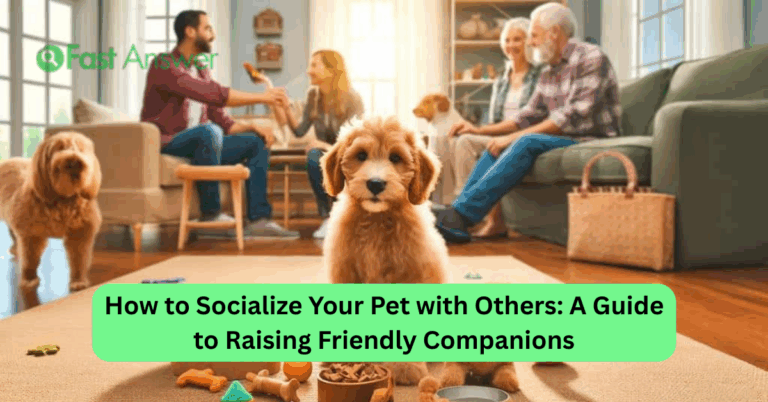How to Help Pets During Fireworks or Storms: Keeping Calm Through Chaos
Fireworks and thunderstorms may be exciting or soothing to humans but to pets, they can be terrifying. Sudden loud noises, flashing lights, and changes in atmospheric pressure can trigger intense anxiety in cats, dogs, and other animals. Knowing how to help pets during fireworks or storms is essential for protecting their emotional well-being and preventing fear-based behaviors like hiding, shaking, barking, or even running away. This article is designed for pet owners who want to create a safe, comforting environment when the skies get noisy and unpredictable, helping pets feel more secure and in control.
Create a Safe Space Where Your Pet Feels Protected
One of the best ways to support a frightened pet is to offer a calm, enclosed space where they feel safe. This might be a crate, a closet, under a bed, or a designated “quiet zone” with soft bedding and familiar scents. Dim the lights, close windows and curtains, and play soft music or white noise to help block out outside sounds.
Some pets naturally seek out a hiding place when they’re scared don’t force them out. Let them retreat to their comfort zone and check in gently. If your pet is crate-trained, adding a favorite blanket or toy can turn it into a soothing den that helps them self-soothe.
Use Calming Products and Techniques to Reduce Anxiety
Many pets respond well to calming aids designed to ease stress during storms and fireworks. These include anxiety wraps like Thundershirts, pheromone diffusers (such as Adaptil or Feliway), calming treats, or vet-approved CBD supplements. These tools won’t sedate your pet but can take the edge off their anxiety, especially when used consistently before stress begins.
Additionally, your own energy matters. Speak in a calm, reassuring voice and act normally. Avoid reinforcing fearful behavior with excessive coddling, which can validate the fear. Instead, provide structure and soothing touch, helping your pet understand there’s no real threat in the environment.
Desensitize and Train in Advance When Possible
If your pet has a known fear of fireworks or storms, start desensitization training long before the next major event. Play recordings of thunder or fireworks at a very low volume while engaging your pet in a positive activity like playtime or treat rewards. Gradually increase the volume over time while maintaining a positive association.
This technique helps your pet associate scary sounds with good experiences and builds resilience over time. It’s especially useful for puppies or young pets still in their critical learning phases. While not a quick fix, consistent desensitization can dramatically reduce the intensity of fear responses.
Don’t Leave Pets Alone During Peak Anxiety Events
Whenever possible, avoid leaving your pet alone during fireworks displays or heavy storms. Having you nearby provides emotional stability and helps prevent panic behaviors like chewing, clawing, or escaping. If you must leave the house, make sure your pet is safely secured indoors, windows and doors are locked, and noise-dampening strategies are in place.
For extreme cases, consider speaking with your veterinarian about temporary anxiety medication. Some pets experience such high levels of distress that short-term medication may be the most humane option during intense noise events like New Year’s Eve or Fourth of July celebrations.
Keep Identification Updated in Case of Escapes
Fearful pets sometimes bolt during storms or fireworks, especially if they manage to get outside. Ensure your pet always wears an ID tag with current contact information, and that microchip details are up to date. Even indoor pets can find unexpected escape routes during panic, so secure entry points and supervise closely during these events.
Reinforce boundaries indoors with baby gates or closed doors, and double-check windows and screen integrity. Taking these steps doesn’t just reduce anxiety it increases safety during moments when fear can override a pet’s usual behavior.
FAQ
1. Why do pets fear fireworks and storms so much?
Loud, unpredictable noises, bright lights, and pressure changes trigger their natural flight response. It’s a survival instinct amplified by their sensitive hearing.
2. Should I ignore my pet when they’re scared?
No, but don’t overly coddle either. Stay calm, be present, and offer reassurance without acting like there’s something wrong. Your confidence helps regulate their response.
3. What are natural ways to help calm my pet?
Try white noise, soothing music, pheromone sprays, pressure wraps, or creating a dark, quiet safe space with familiar bedding and toys.
4. When should I consider medication for my pet’s anxiety?
If your pet becomes destructive, escapes, or shows signs of severe distress, talk to your vet. Short-term anti-anxiety medications may help during specific events.
5. How early should I start preparing my pet for fireworks?
Begin at least a few weeks in advance with desensitization training and by setting up a safe routine. Preparation is key to reducing fear responses.





